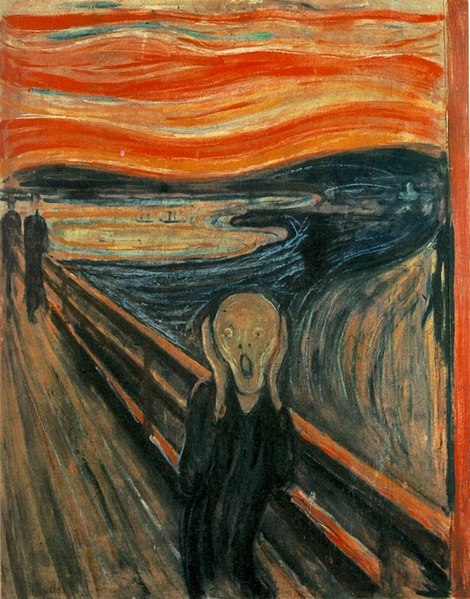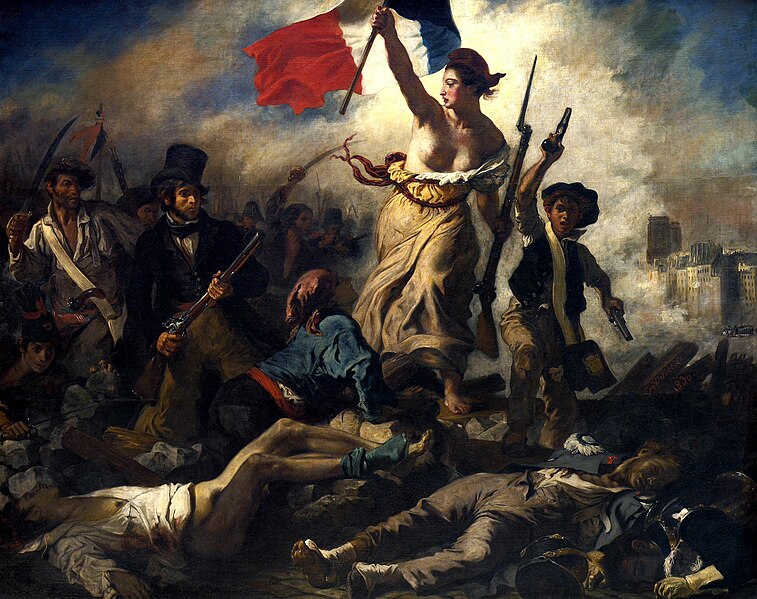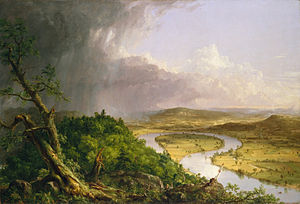All AP Art History Resources
Example Questions
Example Question #111 : Nineteenth Century 2 D Art
Monet and Manet were part of the ___________ movement in the 19th century.
Romantic
Expressionist
Dada
Cubist
Impressionist
Impressionist
Both Monet and Manet are known to be part of the Impressionist movement of the 19th century.
Though their works share characteristics of the Romanticism such as a preference for broad colored stroked over contours, the time period does not match (in fact, Impressionism followed from Romanticism).
Cubism, Expressionism, and Dadaism followed from the impressionist movement and are characterized by different artists. These movements began to gain traction in the beginning of the 20th century.
Example Question #231 : Renaissance To Contemporary 2 D Art
Identify the artist who created this painting.

Eugène Delacroix
Édouard Manet
Edvard Munch
Berthe Morisot
Vincent Van Gogh
Edvard Munch
This painting, The Scream, was created by Munch between 1893 and 1910. It is of the impressionist style that heavily influenced the expressionist movement that followed.
Though Manet and Van Gogh share similar styles to this painting, they both died before the turn of the 20th century. Morisot also died before the 1900s.
Image is in the public domain, accessed through Wikipedia Media Commons: https://commons.wikimedia.org/wiki/File:The_Scream.jpg
Example Question #232 : Renaissance To Contemporary 2 D Art
Identify the artist who created this painting.

Francisco de Goya
Eugène Delacroix
Rembrandt
Sandro Botticelli
Jean-Auguste-Dominique Ingres
Francisco de Goya
This painting, Saturn Devouring His Son, was part of Goya's "Black Paintings" Collection, which was inspired by his disillusionment following the Spanish Inquisition.
The only painters to have a similar style would be Rembrandt and Botticelli, however they do not meet the period of this piece.
Though Delacroix and Ingres created paintings during the early 1800s, they did not create works relating to Greek/Roman mythology, nor did they employ this brushstroke style.
Image is in the public domain, accessed through Wikipedia Media Commons: https://en.wikipedia.org/wiki/Saturn_Devouring_His_Son#/media/File:Francisco_de_Goya,_Saturno_devorando_a_su_hijo_%281819-1823%29.jpg
Example Question #233 : Renaissance To Contemporary 2 D Art
Liberty Leading the People, shown below, was created in 1830 by _____________.

Eugène Delacroix
Paul Cézanne
Jean-Auguste-Dominique Ingres
Édouard Manet
Pierre-Auguste Renoir
Eugène Delacroix
Delacroix is responsible for this piece, and can be identified by the Romantic style employed.
Though Ingres was a contemporary of Delacroix, the two were nemesis and Ingres followed a Neoclassical approach.
Manet, Cézanne, and Renoir were impressionist painters and do not fit the period or the style of this painting.
Image is in the public domain, accessed through Wikipedia Media Commons: https://commons.wikimedia.org/wiki/File:Eug%C3%A8ne_Delacroix_-_La_libert%C3%A9_guidant_le_peuple.jpg
Example Question #234 : Renaissance To Contemporary 2 D Art

Based on style and composition, the work shown here was composed by a member of the artistic group known as _______________.
the Realists
the Norwich School
the Impressionists
the Hudson River School
the Hudson River School
This work, The Oxbow (View From Mount Holyoke, Northampton, Massachusetts, after a Thunderstorm), was painted by Thomas Cole, the founder of the artistic movement known as The Hudson River School. The Hudson River School was the first art movement prevalent in the United States of America, flourishing from 1830-1860. The Hudson River School focused on large scale landscapes, usually of scenes in and around the Hudson River Valley in New York, with a focus on scenes of natural beauty and wonder, oftentimes featuring ominous weather or hazardous wild features.
Artwork from Wikimedia Commons: https://commons.wikimedia.org/wiki/File:Cole_Thomas_The_Oxbow_(The_Connecticut_River_near_Northampton_1836).jpg
Example Question #111 : Nineteenth Century 2 D Art
Paul Gauguin's later work depicts the culture, people, and environment of __________.
Sub-Saharan Africa
Japan
Polynesia
Persia
Polynesia
Paul Gauguin was an important French post-impressionist who had considerable success and personal conflicts in late nineteenth century Paris. Gauguin took his first trip to Polynesia in the 1880s, and began living there nearly full time by 1890. Gauguin's work featured the women of Polynesia in his work in bright colors and interesting poses, and with odd symbolism.
Example Question #1 : Answering Other Questions About Nineteenth Century 2 D Art
The figure in the painting shown in Figure 2 is presented in a pose that makes him appear __________.
imposing
serene
confident
haughty
serene
The use of the many Japanese images behind the central figure suggest a sense of chaos, but the individual's pose suggests serenity and calm. This is an intentional choice by the artist, Vincent van Gogh, so that his subject, Père Tanguy, can have his serene nature enhanced. The comfortable setting and the relaxed position of the arms also strongly contribute to this sense.
Figure 1: The Starry Night by Vincent van Gogh (1889)
Figure 2: Portrait of Père Tanguy by Vincent van Gogh (1887-8)
Example Question #2 : Answering Other Questions About Nineteenth Century 2 D Art
The painting shown in Figure 2 uses artwork and style from __________.
Polynesia
China
Japan
Persia
Japan
The Japanese government underwent a major shift in 1868 with the "Meiji Restoration," which saw it open up to outside powers for the first time in centuries. In Europe, this sparked an intense interest in Japanese art traditions, particularly among impressionists and post-impressionists. Vincent van Gogh was one of many artists to place Japanese artwork into his own work, as in his Portrait of Père Tanguy from 1887-8.
Figure 1: The Starry Night by Vincent van Gogh (1889)
Figure 2: Portrait of Père Tanguy by Vincent van Gogh (1887-8)
Example Question #114 : Nineteenth Century 2 D Art


Figure 3 Figure 4
The above paintings portray the chief generals of __________.
the Battle of Waterloo
the Battle of Gettysburg
the Battle of Yorktown
the Battle of Agincourt
the Battle of Waterloo
These two paintings portray the most famous generals of early nineteenth century Europe. The painting in Figure 3 portrays Napoleon Bonaparte, as painted by Jacques-Louis David, and the painting in Figure 4 portrays Arthur Wellesley, Duke of Wellington, as painted by Sir Thomas Lawrence. These two men met in battle numerous times, most famously at Waterloo in 1815, in Southern Belgium. There, Wellington's allied forces soundly defeated Napoleon's Grand Army of France, forcing him into a second and more permanent exile.
Figure 3: Napoleon Crossing the Alps by Jaques-Louis David (1801)
Figure 4: Portrait of Sir Arthur Wellesley, First Duke of Wellington by Sir Thomas Lawrence (1814)
Example Question #115 : Nineteenth Century 2 D Art
The type of photographic process which placed the image on a silver plate was the __________.
camera obscura
tintype
daguerreotype
negative
daguerreotype
A daguerreotype was a laborious process, which captured an image on a piece of silver, which then had to be rubbed with various chemicals to make the image appear; nonetheless, the daguerreotype, named after its inventor Louis Daguerre, was the first easily reproduceable photographic process on its creation in 1837. The daguerreotype was supplanted by the 1860s with a variety of quicker methods.
Certified Tutor
All AP Art History Resources






